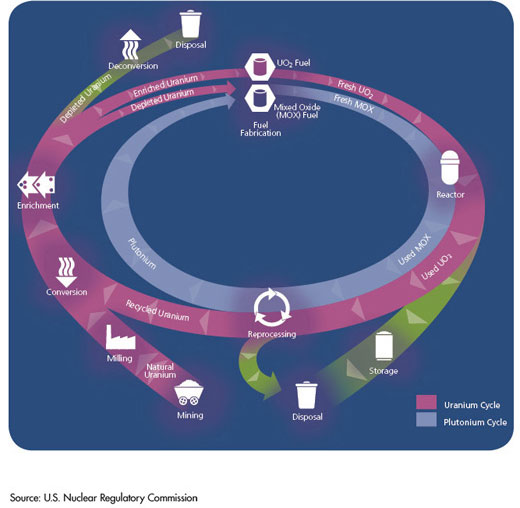The nuclear fuel cycle uses uranium in different chemical and physical forms. As illustrated below, this cycle typically includes the following stages:
- Uranium recovery to extract (or mine) uranium ore, and concentrate (or mill) the ore to produce "yellowcake"
- Conversion of yellowcake into uranium hexafluoride (UF6)
- Enrichment to increase the concentration of uranium-235 (U235) in UF6
- Deconversion to reduce the hazards associated with the depleted uranium hexafluoride (DUF6), or "tailings," produced in earlier stages of the fuel cycle
- Fuel fabrication to convert enriched UF6 into fuel for nuclear reactors
- Use of the fuel in reactors (nuclear power, research, or naval propulsion)
- Interim storage of spent nuclear fuel
- Reprocessing (or recycling) of high-level waste (currently not done in the U.S.) [1]
- Final disposition (disposal) of high-level waste

[1] Neither a recycling/reprocessing facility nor a Federal waste repository is currently approved (licensed) in the United States, and spent fuel is in interim storage. However, the NRC is currently reviewing a license application for a new Mixed-Oxide Fuel Fabrication Facility, which would recycle surplus weapon-grade plutonium, remove impurities, and mix it with uranium oxide to form mixed-oxide (MOX) fuel pellets for use in reactor fuel assemblies. For additional information, see the Backgrounder on Mixed Oxide Fuel and the Frequently Asked Questions About Mixed Oxide Fuel.
Resource: http://www.nrc.gov/materials/fuel-cycle-fac/stages-fuel-cycle.html
Resource: http://www.nrc.gov/materials/fuel-cycle-fac/stages-fuel-cycle.html
No comments:
Post a Comment